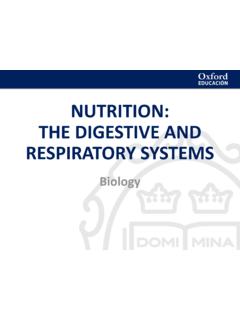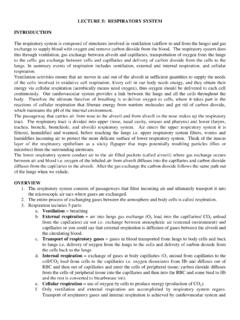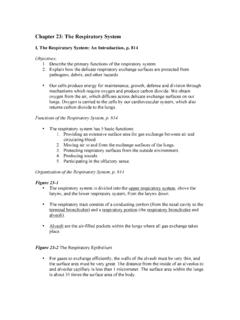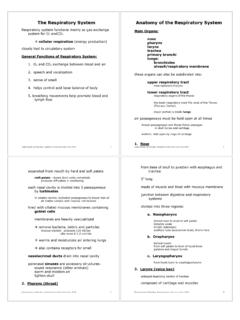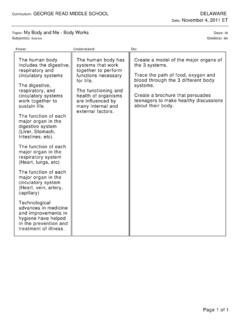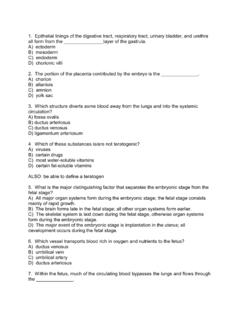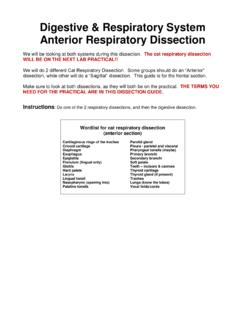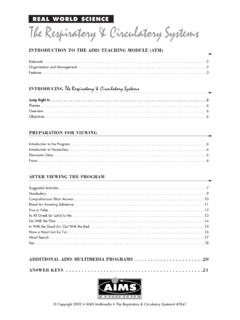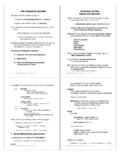Transcription of 548 www.ck12.org HAPTER 19MS Respiratory and Excretory …
1 Respiratory and HEALTH OF above image shows the tissue found inside of the lungs. The lungs contain alveoli. Alveoli absorb oxygen andsend it to the blood vessels. They also move carbon dioxide from the blood vessels back to the lungs to be look like clumps of grapes. Why do you think it is important that your body have many alveoli? What wouldhappen if your alveoli lost their ability to function? Why do you think alveoli are shaped like spheres?The Respiratory system is important because it brings oxygen to cells in your body. But it also removes a waste,carbon dioxide. Another system in your body, the Excretory system , also removes wastes. The Excretory systemmoves waste from your digestive system and from your blood out of your do the Respiratory system and Excretory system work together?
2 How does damage in one system affect theother? Consider these questions about respiration and waste removal as you read the following 19. MS Respiratory AND Excretory Respiratory SystemLesson Objectives Identify the parts of the Respiratory system . Identify the main function of the Respiratory system . Describe how breathing works. Outline how the Respiratory system and the cardiovascular system work together. Identify how breathing and cellular respiration are Your Understanding What is an organ system ? What is the role of the circulatory system ? How does your blood get oxygen?VocabularyalveoliLittlesacsat the end of the bronchioles where most of the gas exchange sheet of muscle that extends across the bottom of the rib flap of connective tissue that closes over the trachea when food is swallowed; prevents choking orinhaling air out of the body through the nose or respirationThe movement of oxygen into the body and carbon dioxide out of the exchangeThe movement of oxygen across a membrane and into the blood and the movement of carbon diox-ide out of the air into the body through the nose and respirationThe exchange of gases between the blood and the cells of the just below the point at which the pharynx splits into the trachea and the esophagus.
3 Your voicecomes from your larynx; air from the lungs passes across thin membranes in the larynx and produces sound;also called the THE Respiratory long tube that is shared with the digestive system ; both food and air pass through the process of getting oxygen into the body and releasing carbon systemThe organ system that allows oxygen to enter the body and carbon dioxide to leave your long tube that leads down to the chest where it divides into the right and left bronchi in the lungs; alsocalled the of the Respiratory SystemYou breathe mostly without thinking about it. Remember how uncomfortable you felt the last time you had a coldor a cough? You usually do not think about your Respiratory system or how it works until there is a problem with cell in your body depends on your Respiratory systemis made up of the tissues and organs that allow oxygen to enter the body and carbon dioxideto leave your body.
4 Organs in your Respiratory system include your: Nose. Mouth. Larynx. Pharynx. Lungs. structures are shown .Parts of the Respiratory shows many of the structures of the Respiratory system . Each of the parts has a specific job. The partsof the Respiratory system include the following: Thediaphragmis a sheet of muscle that spreads across the bottom of the rib cage. When the diaphragmcontracts, the chest volume gets larger and the lungs take in air. When the diaphragm relaxes, the chestvolume gets smaller and air is pushed out of the lungs. The nose and nasal cavity filter, warm, and moisten the air you breathe. The nose hairs and mucus producedby the cells in the nose catch particles in the air and keep them from entering the lungs.
5 When particles in theair do reach the lungs, what do you think happens? Behind the nasal cavity, air passes through thepharynx, a long tube. Both food and air pass through thepharynx. Thelarynx, also called the "voice box," is found just below the pharynx. Your voice comes from your from the lungs passes across thin tissues in the larynx and produces sound. Thetrachea, or windpipe, is a long tube that leads down to the lungs, where it divides into the right and leftbronchi. The bronchi branch out into smaller bronchioles in each lung. Since food goes down the pharynx, how is it stopped from entering the trachea? A flap of tissue called theepiglottiscloses over the trachea when food is swallowed to prevent choking or inhaling 19.
6 MS Respiratory AND Excretory Respiratory system . Air moves inthrough the nose and mouth and downthe trachea which is a long straight tubein the THE Respiratory The bronchioles lead to the the little sacs at the end of the bronchioles. They look likelittle bunches of grapes, as shown . Oxygen is exchanged for carbon dioxide in the exchangeis the name we give to the process that allows oxygen to enter the blood and carbon dioxide tomove out of the blood - the two gases are "exchanged."FIGURE alveoli are the tiny grape-like struc-tures in the lungs and the sites of We BreatheMost of the time, you breathe without thinking about it. Breathing is mostly an involuntary action that is controlledby a part of your brain that also controls your heart beat.
7 If you swim, do yoga, or sing, you know you can alsocontrol your breathing. Taking air into the body through the nose and mouth is calledinhalation. Pushing air outof the body through the nose or mouth is calledexhalation. The man is exhaling before he surfacesfrom the pool do lungs allow air in? As mentioned above, air moves into and out of the lungs by the movement of diaphragm and rib muscles contract and relax to move air into and out of the lungs. During inhalation, thediaphragm contracts and moves downward. The rib muscles contract and cause the ribs to move outward. Thiscauses the chest volume to increase. Because the chest volume is larger, the air pressure inside the lungs is lowerthan the air pressure outside.
8 This difference in air pressures causes air to be sucked into the lungs. When thediaphragm and rib muscles relax, air is pushed out of the lungs. Exhalation is similar to letting the air out of walls of the alveoli are very thin and allow gases to enter into them. The alveoli are lined with capillaries. Thesecapillaries are shown . Oxygen moves from the alveoli to the blood in the capillaries that surroundthe alveoli. At the same time, carbon dioxide moves in the opposite direction, from capillary blood to the 19. MS Respiratory AND Excretory able to control breathing is impor-tant for many activities such as swim-ming. The man in the photograph is ex-haling before he surfaces from the bronchi and alveoli.
9 During respira-tion oxygen gets pulled into the lungsand enters the blood by passing acrossthe thin alveoli membranes and into THE Respiratory and RespirationWhen you breath in, oxygen is drawn in through the mouth and down into the lungs. The oxygen then passes acrossthe thin lining of the capillaries and into the blood. The oxygen molecules are carried to the body cells by the dioxide from the body cells is carried by the blood to the lungs where it is released into the air. The processof getting oxygen into the body and releasing carbon dioxide is breathing is called respiration, but there is much more to respiration than just breathing. There areactually two parts to respiration, external respiration and internal respirationis the movementof oxygen into the body and carbon dioxide out of the respirationis the exchange of oxygen andcarbon dioxide between the blood and the cells of the body ( ).
10 The Journey of a Breath of AirBreathing is only part of the process of bringing oxygen to where it is needed in the body. After oxygen enters thelungs, what happens?a. The oxygen enters the blood stream from the alveoli. Then, the oxygen-rich blood returns to the Oxygen-rich blood is then pumped through the From the aorta, oxygen-rich blood travels to the smaller arteries and finally to the The oxygen molecules move out of the capillaries and into the body While oxygen moves from the capillaries and into body cells, carbon dioxide moves from the cells into exchange is the movement of oxy-gen into the blood and carbon dioxideout of the and Cellular RespirationThe oxygen that arrives at the cells from the lungs is used by the cells to help release the energy stored in molecules ofsugar.
